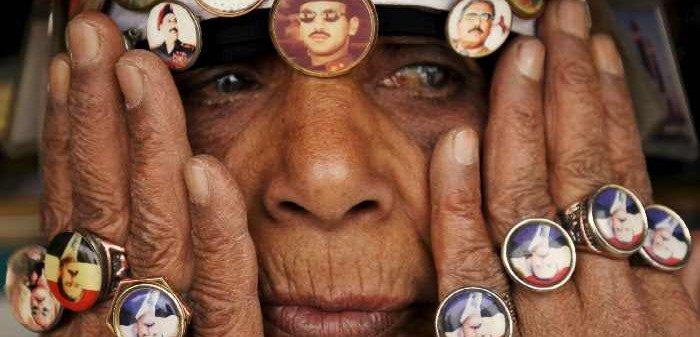Unraveling Yemen’s Civil War
More than sectarianism or foreign intervention, the civil war is driven by broken politics. In Yemen, the self-interest of leaders creates political dead ends.

A woman with pins showing pictures of former President Saleh and his son at a rally against airstrikes, Sanaa, April 3, 2015. Mohamed Al-Sayaghi/Reuters/Corbis
Meeting with Yemeni politicians during a recent trip to Riyadh—ostensibly all supporters of Yemeni President Abdu Rabbu Mansour Hadi’s government—it was remarkable how harsh criticisms of Hadi, his closest allies, and their leadership capacity dominated the discussion. Such criticisms even outnumbered expressions of disdain for the rebels who had forced their flight from Yemen to Saudi Arabia in the first place.
It is a testament to the deep fissures long underlining Yemen’s political scene: trust between various sides has collapsed. A casual reading of the political roadmap suggests a war being waged by two sides—that is, the country’s Saudi-backed government and the rebels who overthrew them in a coup. The reality is far more complicated. Both factions may allege that they constitute “one hand” against their opponents, but any look below surface level only underlines the extent to which Yemen’s political scene remains riddled by divides, new and old.
This is the case both within and without the country’s political establishment. While the ultimate results of the Saudi-led military operation against the Houthis and their allies remain to be determined, one of its key consequences appears to be the unraveling of Yemen’s political order. The divide between former President Ali Abdullah Saleh’s General People’s Congress party and the opposition Joint Meeting Parties—a coalition of the Sunni Islamist Islah party, Yemen’s Socialist Party, and other smaller factions—has effectively dissipated owing to nearly existential fractures within Yemen’s traditional political groupings. Leaders within the same party have taken different sides. Simultaneously, groups outside the system—most notably, the Houthis and secessionist Southern Movement, but also tribal groupings in numerous provinces, specifically resource-rich Marib—have formed strategic relationships with various sides in the conflict. That being said, despite these fragile ties, all have retained their own separate interests and aims. While many may place focus on politicians speaking in the name of the central government, the inclusion of locally rooted, non-traditional groupings will be a necessity in any potential political negotiations or settlement.
Much attention has—unsurprisingly—focused on the presence of small numbers of fighters with ties to Al-Qaeda in the ranks of anti-Houthi resistance militias. But while Al-Qaeda and other extremist groups are likely to continue posing a challenge to those trying to restore order, the deeper challenge lies in rebuilding a political system that long ago fundamentally broke down, leaving a void no political actor seems able to fill.
At the moment, this remains most flagrantly on display in Yemen’s south, where longstanding adversaries—specifically, backers of the pro-unity Islah party and the secessionist Southern Movement—fought alongside each other to expel the Houthis, but have since engaged in a fierce media war with each other that many worry will eventually move from words to bullets. At the moment, the city of Aden remains plagued by disorder and occasional violence.
Such divides continue to riddle both sides of the conflict. The relationship between the Houthis and Saleh’s allies remains characterized by deep distrust. Leaders in Saleh’s party have privately admitted to me that, in absence of the Saudi-led military operation, the two allies would easily have come to blow themselves. On the other side, high-ranking officials in the exiled government have almost openly expressed their lack of faith in—and, in some cases, revulsion with—President Hadi.
There’s a tendency to cast these splits as essentially rooted in the Saudi-lead intervention or the aggressive actions of the Houthis and their allies. But while Gulf offers of patronage may have swung some figures, the fact remains that, more than anything, the conflict is rooted in decades-old issues. Yemen’s conflict is, undoubtedly, a civil war spurred by the deep mismanagement of a political crisis. But it is also far more: the explosion of a surfeit of long-simmering tensions.
While the media mouthpieces of both sides in the conflict would suggest otherwise, the civil war is not—at its essence—the result of either Houthi malfeasance or the alleged malevolence of Yemen’s neighbors. It is the fruit of more than two decades of missed opportunities. The latest was Yemen’s “Conference of National Dialogue.” Despite being celebrated by key international actors, the conference effectively constituted a spectacularly mismanaged summit of political theater, manned by a well-paid cast of Yemeni elites and held in one of the acutely impoverished country’s few five-star hotels.
Moving forward will require confronting past mistakes. Unfortunately, when it comes to Yemen’s recent history, these are manifold, ranging from the flawed handling of the 1990 unification of Yemen’s formerly independent north and south, to the marginalization of southerners following the defeat of pro-secession forces in the country’s 1994 civil war, to the Saleh regime’s botched responses to the Houthi movement—which only served to radicalize the group. Last but not least, there’s the spectacular failure of the internationally backed, post-Arab Spring transitional government established under the rule of Saleh’s successor and long time vice president, Abdu Rabbu Mansour Hadi.
Few, if any, key stakeholders have demonstrated any semblance of accountability. If there’s one thing Yemen’s warring factions have in common, it is their tendency to shirk responsibility for the country’s current state by laying the blame on others. Regrettably, this suggests that the lessons of the past are unlikely to be learned any time soon.
Adam Baron, a journalist based in Sanaa from 2011 to 2014, is a visiting fellow at the European Council on Foreign Relations (ECFR). On Twitter: @adammbaron.




